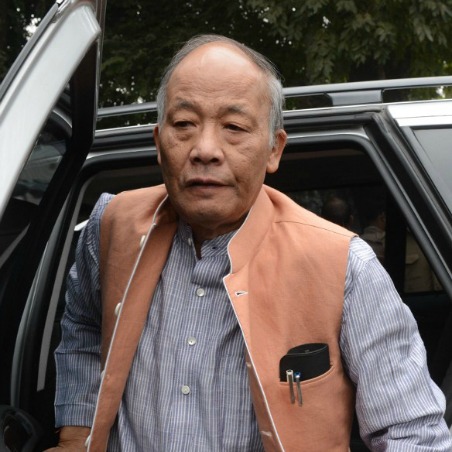Crisis over demand for ILP deepens in Manipur
By Khelen Thokchom

Activists demand inner-line permit in Imphal on Sunday.
Imphal, Aug 17 : Manipur chief minister Okram Ibobi Singh has convened an all-party meet tomorrow to finalise a draft bill prepared by his government for protection of indigenous people of the state.
Ibobi Singh convened the meet after the ongoing crisis over the public demand for inner-line permit (ILP) or a similar legislation deepened with more ILP supporters joining the indefinite hunger strike today.
Life continues to be severely affected because of ILP agitation for more than a month.
Police arrested five students, including a girl, who were on
indefinite hunger strike since Friday in support of ILP at Ananda Singh
Higher Secondary Academy in Imphal East, late last night.
The students are undergoing treatment at the Regional Institute of Medical Sciences here.
Principal magistrate of Imphal East A. Noutuneshori today remanded the five students in two juvenile homes in Imphal till August 29. They will be taken to the juvenile homes after their condition improves, an official source said.
"The chief minister has convened an all party meet tomorrow at 2pm to discuss means to end the deadlock and discuss the draft bill," an official source said.
The state government has drafted a bill and Ibobi Singh would discuss with the political delegations the demand for inclusion of five points raised by the Joint Committee on ILP, a public conglomerate that has been spearheading the agitation.
The five points are permit for outsiders, identification of outsiders with 1951 as the cut-off year, deportation of the identified outsiders, no land ownership right to non-locals and strengthening of the labour department.
Today, five more students, including two girls, began an indefinite hunger strike at the gate of Ananda Singh Higher Secondary Academy.
Six other persons, including students, also began their hunger strike near the home of Sapam Robinhood, who was killed in a police crackdown on ILP supporters on July 8 in Imphal East.
Robinhood, who hailed from Lairikyengbam Leikai in Imphal East, was a class XI student of Ananda Singh Higher Secondary Academy.
Robinhood's father Sapam Romesh was admitted to Shija Hospitals yesterday after he fell ill. His condition is stated to be stable.
Two other ILP activists are also on an indefinite hunger strike at Thangmeiband in Imphal city since yesterday.
Protesters turned out on the streets today to block the roads in support of ILP after the news of the arrest of five students spread.
The police said the agitation was more intense at Khurai, Robinhood's neighbourhood. The police last night fired tear gas shells at various places to disperse torch rallies heading for Imphal city.
Several protesters were injured. Ibobi Singh is also expected to review the situation arising out of the signing of a peace accord between NSCN (Isak-Muivah) and the Centre on August 3, during tomorrow's all party meet.
By Khelen Thokchom

Activists demand inner-line permit in Imphal on Sunday.
Imphal, Aug 17 : Manipur chief minister Okram Ibobi Singh has convened an all-party meet tomorrow to finalise a draft bill prepared by his government for protection of indigenous people of the state.
Ibobi Singh convened the meet after the ongoing crisis over the public demand for inner-line permit (ILP) or a similar legislation deepened with more ILP supporters joining the indefinite hunger strike today.
Life continues to be severely affected because of ILP agitation for more than a month.
The students are undergoing treatment at the Regional Institute of Medical Sciences here.
Principal magistrate of Imphal East A. Noutuneshori today remanded the five students in two juvenile homes in Imphal till August 29. They will be taken to the juvenile homes after their condition improves, an official source said.
"The chief minister has convened an all party meet tomorrow at 2pm to discuss means to end the deadlock and discuss the draft bill," an official source said.
The state government has drafted a bill and Ibobi Singh would discuss with the political delegations the demand for inclusion of five points raised by the Joint Committee on ILP, a public conglomerate that has been spearheading the agitation.
The five points are permit for outsiders, identification of outsiders with 1951 as the cut-off year, deportation of the identified outsiders, no land ownership right to non-locals and strengthening of the labour department.
Today, five more students, including two girls, began an indefinite hunger strike at the gate of Ananda Singh Higher Secondary Academy.
Six other persons, including students, also began their hunger strike near the home of Sapam Robinhood, who was killed in a police crackdown on ILP supporters on July 8 in Imphal East.
Robinhood, who hailed from Lairikyengbam Leikai in Imphal East, was a class XI student of Ananda Singh Higher Secondary Academy.
Robinhood's father Sapam Romesh was admitted to Shija Hospitals yesterday after he fell ill. His condition is stated to be stable.
Two other ILP activists are also on an indefinite hunger strike at Thangmeiband in Imphal city since yesterday.
Protesters turned out on the streets today to block the roads in support of ILP after the news of the arrest of five students spread.
The police said the agitation was more intense at Khurai, Robinhood's neighbourhood. The police last night fired tear gas shells at various places to disperse torch rallies heading for Imphal city.
Several protesters were injured. Ibobi Singh is also expected to review the situation arising out of the signing of a peace accord between NSCN (Isak-Muivah) and the Centre on August 3, during tomorrow's all party meet.













